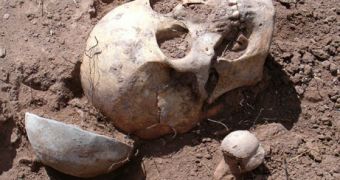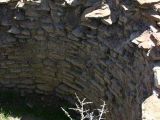This is one of the most mysterious cultures of the New World. The obscure native culture named Gallina occupied a small zone of northwestern New Mexico around A.D. 1100 but by 1275 they were all gone.
Now, seven Gallina skeletons (five adults, one child and one infant), appearing to have been victims of a brutal massacre in an ancient campaign of genocide, could solve more of their mystery.
"The newfound skeletons could provide crucial clues to the people's mysterious fate, since scarcely more than a hundred Gallina remains have ever been found," said Tony Largaespada, an archaeologist with the U.S. Forest Service who made the discovery in 2005.
"Almost all of [the Gallina ever found] were murdered. [Someone] was just killing them, case after case, every single time."
"It's pretty obvious that they were killed-they're people who were wiped out. One skeleton was found with a fractured skull, forearm, jaw, thighbone, pelvis, and several broken ribs. Another bore cut marks on the upper arm that suggest blows from an ax. The child, about two years old, had had its skull crushed." said co-author Greg Nelson, a physical anthropologist at the University of Oregon.
What's unusual about the new discovery are the flattened shape skulls of two of the victims, never found before in the Southwest US, pointing to a distinct culture from the neighboring ones.
"The evidence indicates that somebody was going through and killing them. Why and to what extent? We're not sure." said Nelson.
Very peculiar is the arrangement of two of the bodies, an adult male and female, discovered face down and doubled over, their heads snapped back so far that their heads reached their shoulder blades.
"The bodies may have been deliberately posed, or the victims may have been crouching in defense when their necks were broken," Nelson noted.
All the bodies seem not to have been buried, a sign of being the victims of a rapid and smooth attack. "Normally when you bury people, you extend them, you flex them, you do these kinds of things-you don't bury them on their knees with their heads snapped back." said Nelson.
The remains of a burned pit house were found nearby.
"Usually [attackers] threw [Gallina victims] in their houses and burned the houses on top of them. That's the case with 90 % of them. But in this particular case they were thrown in a pile outside the house. ? More than likely there are others [nearby]." said Largaespada.
The team intends to continue investigation at the site, but also in other close Gallina ruins.
"I bet there's a house on every one of these peaks around here," Largaespada said.
Gallina culture was first found in the 1930s at just a few miles from the newfound site: it was a 25 ft (7.6 m) tall circular stone tower with the remains of 16 people, all being the victims of gruesome deaths.
"Since then several Gallina sites have been excavated, but scholarship on the culture's origins and demise have been limited," Nelson noted.
It is not clear whether Gallina were the victims of real genocide (the extermination of one ethnic group by another) or not. "It could've been within the Gallina. A crucial factor is the severe drought that struck the Southwest soon after the culture's appearance around A.D. 1100. Beginning in 1100, 1150, you start getting real drought conditions, and the water table starts dropping. That means you're not able to grow as much corn. So there's a chance that this is [a sign of] intervillage resource-stress problems." said Nelson.
The same "megadrought" triggered mass migrations throughout the area, even the abandonment of massive settlements built by the Anasazi (a group of Pueblo People).
Faced with dire competition for water and land, the Gallina could have been particularly vulnerable if regarded as outsiders. "If you live in the area, you're growing your corn, and new people come in. Then the environment goes down the tubes. Let's blame the new people. We don't know you. Maybe you speak a different dialect. And we can't grow our corn anymore. You must be witches, so we're just going to kill you." said Nelson.
"Perhaps the most distinct clues revealed by the new discovery are the two deformed skulls that Nelson first observed." said Heather Edgar, curator at Albuquerque's Maxwell Museum of Anthropology.
"The skulls are flattened on the back, just below the crown. The deformation must have occurred during infancy, when the victims' skull bones were soft and malleable," said Nelson.
The team has not investigated yet if the deformations were intentional or just the result of cradleboarding (carrying babies on boards bundled to mothers' backs).
"Where did they come from, and where did they go? Did [the Gallina] contribute to a population that's alive today, and we just aren't aware of that? Or did they just move to another region? And there are theories out there that they were all massacred," pointed Edgar.

 14 DAY TRIAL //
14 DAY TRIAL // 
